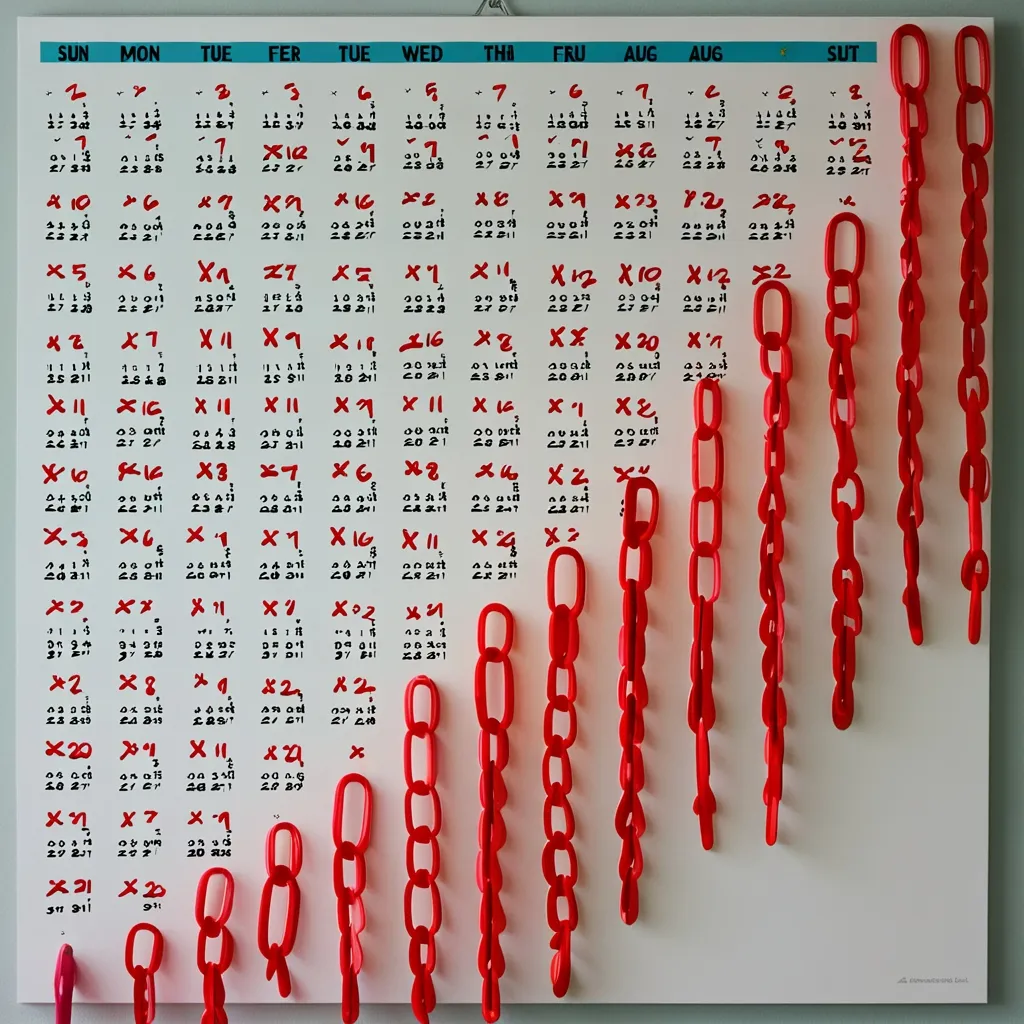The Seinfeld Strategy: Unlocking Your Potential One Day at a Time
Ever feel like your big dreams are just out of reach? You’re not alone. We’ve all been there, staring at our goals and wondering how we’ll ever make them happen. But what if I told you there’s a simple trick that could change everything? Enter the Seinfeld Strategy, a game-changer in the world of productivity.
This isn’t your typical, boring productivity hack. Nope, it’s a fun, easy-to-use method that even has a cool backstory. Picture this: a young, eager comedian walks up to the legendary Jerry Seinfeld and asks for advice. Instead of brushing him off, Seinfeld drops a golden nugget of wisdom that would go on to help countless people achieve their dreams.
So, what’s the big secret? It’s all about not breaking the chain. Sounds mysterious, right? Don’t worry, I’ll break it down for you.
The idea is simple. You take a big wall calendar and a red marker. Every day you work on your goal, you mark a big red ‘X’ on that day. As the days go by, you start to see a chain forming. Your only job? Don’t break that chain.
Now, you might be thinking, “That’s it? How can something so simple be so effective?” Well, my friend, that’s the beauty of it. The Seinfeld Strategy works because it taps into some pretty cool aspects of human psychology.
First off, it makes big, scary goals feel way less intimidating. Instead of freaking out about writing a whole book, you just focus on writing a little bit each day. It’s like eating an elephant (not that you should!) - you do it one bite at a time.
Then there’s the whole gamification aspect. Each ‘X’ you mark feels like a win, and who doesn’t love winning? It’s like playing a game, but the prize is achieving your dreams. Pretty sweet deal, if you ask me.
But here’s where it gets really interesting. As your chain of ‘X’s grows, you start to feel this weird sense of responsibility to keep it going. Breaking the chain starts to feel like losing, and our brains hate losing even more than they love winning. It’s like a Jedi mind trick you play on yourself.
Now, let’s talk about how you can use this in your own life. Maybe you’ve always wanted to write a novel but never knew where to start. With the Seinfeld Strategy, you could commit to writing 500 words every day. It doesn’t matter if those words are pure gold or total garbage - what matters is that you’re showing up and doing the work.
Or maybe you’re trying to get in shape. Instead of setting a vague goal like “lose weight,” you could commit to doing 10 push-ups every day. It might not seem like much, but those push-ups will add up over time. Plus, once you’re on the floor, you might find yourself doing a few extra exercises. Before you know it, you’ve got a full workout routine going.
The best part? You can use this strategy for pretty much anything. Learning a new language? Commit to studying for 15 minutes every day. Want to start a business? Spend 30 minutes each day working on your business plan. The possibilities are endless.
But let’s be real for a second. Life happens, and there might be days when you just can’t keep the chain going. Maybe you get sick, or you have a family emergency, or you just have one of those days where everything goes wrong. It’s okay. The key is not to let one missed day turn into two, then three, then a whole week.
If you miss a day, don’t beat yourself up about it. Just pick up where you left off the next day. Remember, it’s not about being perfect; it’s about being consistent over the long haul.
Speaking of the long haul, that’s where the Seinfeld Strategy really shines. It’s not a quick fix or a 30-day challenge. It’s about building habits that last a lifetime. Think about it - if you write 500 words every day for a year, that’s 182,500 words. That’s two novels! If you do 10 push-ups every day for a year, that’s 3,650 push-ups. You’ll be ripped!
But here’s the thing - it’s not really about the numbers. It’s about who you become in the process. By showing up day after day, you’re not just working towards a goal; you’re becoming the kind of person who achieves their goals. You’re building discipline, consistency, and resilience. These are skills that will serve you well in every area of your life.
Now, you might be wondering if you can use this strategy for multiple goals at once. The short answer is yes, but proceed with caution. It’s usually best to start with one habit and get comfortable with the process before adding more. Once you’ve got one chain going strong, you can start another. Before you know it, you’ll have a whole web of awesome habits!
Let’s look at some real-life examples to drive this home. Say you’re a aspiring musician. Your daily habit could be practicing your instrument for 30 minutes. As the days go by and your chain grows, you’ll notice your skills improving. Those difficult chords that used to trip you up? They’ll start to feel natural. That song you’ve been struggling with? You’ll nail it.
Or maybe you’re trying to eat healthier. Your daily habit could be eating one serving of vegetables with every meal. It might not seem like much, but over time, it’ll add up. You might find yourself craving veggies instead of junk food. Your energy levels might improve. You might even inspire your friends and family to eat healthier too.
The beauty of the Seinfeld Strategy is that it works for both personal and professional goals. Want to be a better public speaker? Practice for 5 minutes every day. Want to improve your coding skills? Solve one coding problem daily. Want to be more mindful? Meditate for 10 minutes each morning.
But here’s a pro tip: make your daily task so easy that it feels almost ridiculous not to do it. If you’re trying to build a reading habit, don’t commit to reading a book a day. Start with reading one page. It’s so easy that you’ll have no excuse not to do it. And often, once you start, you’ll find yourself doing more than you planned.
Now, let’s talk about how to set up your Seinfeld Strategy system. The classic method is to use a wall calendar and a big red marker. There’s something satisfying about physically marking those ‘X’s. But if you’re more of a digital person, there are plenty of apps and tools you can use. Habit trackers like Habitica or Streaks can work great. You can even use a simple spreadsheet if that’s more your style.
The key is to make it visible. Put that calendar somewhere you’ll see it every day. Make it your phone’s wallpaper. Set reminders. Do whatever it takes to keep your chain front and center in your mind.
As you get into the groove of your new habit, you might find yourself wanting to do more. That’s great! But be careful not to burn yourself out. Remember, consistency is more important than intensity. It’s better to do a little bit every day than to do a lot one day and nothing the next.
One cool thing about the Seinfeld Strategy is how it can change your perspective on time. Instead of always focusing on the end goal, you start to appreciate the day-to-day progress. You begin to understand that big achievements are just the result of small, consistent efforts over time.
It’s also worth noting that this strategy can help with more than just productivity. It can be a powerful tool for mental health too. If you’re dealing with anxiety or depression, committing to a small daily act of self-care can make a big difference. It could be something as simple as writing down three things you’re grateful for each day.
As you stick with your habit, you might notice some unexpected benefits. Maybe you start sleeping better because you’re exercising regularly. Maybe you make new friends because you’re consistently showing up at language exchange meetups. Maybe you discover a hidden talent because you’ve been consistently practicing a new skill.
The Seinfeld Strategy isn’t just about achieving goals; it’s about becoming the best version of yourself. It’s about proving to yourself that you can commit to something and see it through. It’s about building confidence and self-trust.
So, are you ready to start your own chain? Remember, it doesn’t matter how small you start. What matters is that you start. Pick a goal, choose a daily action, grab a calendar, and get going. Before you know it, you’ll have a chain so long you won’t even think about breaking it.
And who knows? Maybe one day, years from now, some young hopeful will come up to you asking for advice. And you’ll be able to share the wisdom that Jerry Seinfeld once shared: Don’t break the chain. It’s simple, it’s powerful, and it just might change your life.






